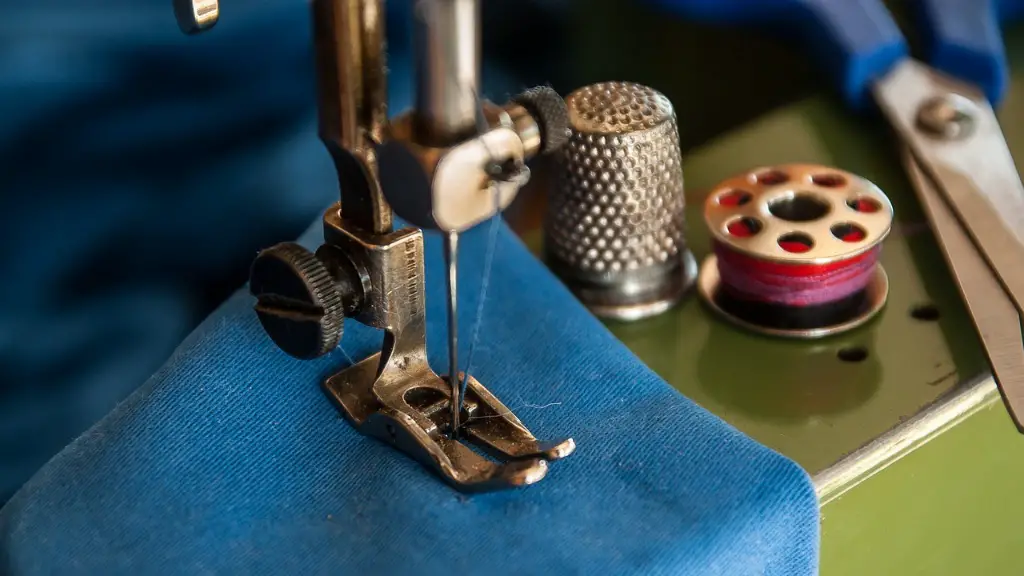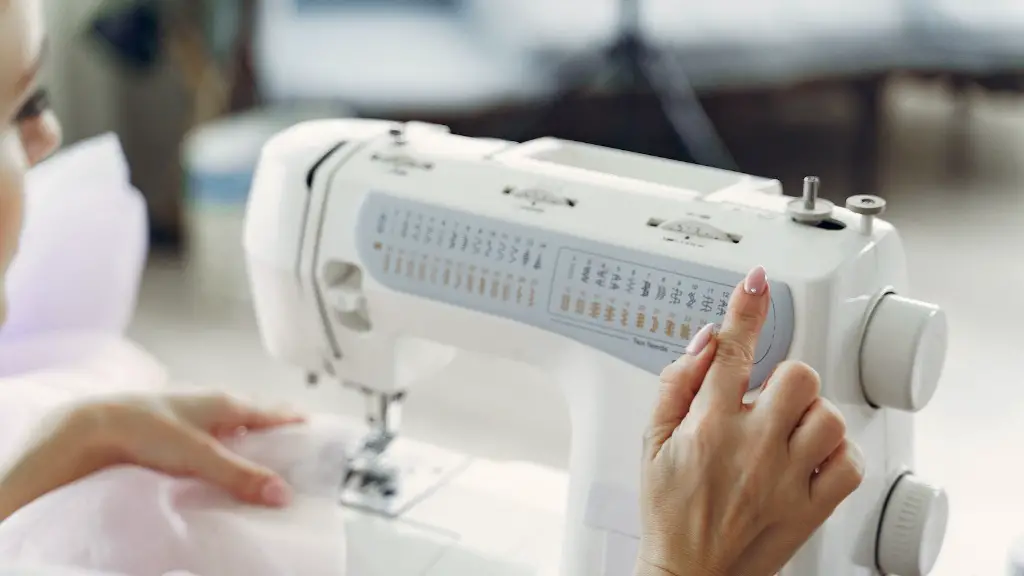If you’re looking to take your sewing to the next level, learning how to sew with a pattern is a great place to start. While it may seem daunting at first, sewing with a pattern is actually fairly simple – all you need is a sewing machine and a bit of patience. In this guide, we’ll walk you through the basics of sewing with a pattern, from choosing the right fabric to cutting out the pieces. By the end, you’ll be ready to tackle any sewing project, no matter how complex.
To sew a pattern with a sewing machine, you will need to first gather your materials. You will need a sewing machine, thread, fabric, a pattern, and a sewing needle. Once you have all of your materials, you will need to set up your sewing machine. To do this, you will need to thread your machine with the proper type and color of thread. Once your machine is threaded, you will need to set the tension. The tension setting will determine how tight or loose your stitches will be.
After your machine is prepared, you will need to select the proper stitch. The type of stitch you use will depend on the fabric you are using and the pattern you are following. Once you have selected the proper stitch, you will need to follow the pattern. Most patterns will have a specific set of instructions that you will need to follow. These instructions will tell you what order to sew the pieces of the pattern together.
Once you have sewn the pattern together, you will need to finish the edges. To do this, you can use a zigzag stitch or a serger. A zigzag stitch will help to prevent the fabric from fraying. A serger will give your project a professional finish.
What is the easiest sewing pattern for a beginner?
If you’re looking for some great sewing patterns to get started with, here are five of the best:
1. Tilly and the Buttons – Cleo
This is a great pattern for beginners because the instructions are easy to follow.
2. Grainline Studios – Scout Tee
This is a quick and simple sew, perfect for those just starting out.
3. Leisl & Co – Everyday Skirt
This is a well-drafted pattern that will become a staple in your wardrobe.
4. Tilly And The Buttons – Coco
This is a great pattern for those who want to sew a stylish and classic dress.
5. Sew Over It – The Ultimate Shift Dress
This is the perfect pattern for beginners who want to sew a simple but chic dress.
You can use a pencil and putting dots through your pattern you can dot along it and then once it’s complete you can lift your pencil up and the dots will be your guidelines.
How do you use a sewing pattern without cutting it
When you are tracing a pattern, it is helpful to align the straight edge of the tracing paper with any straight edges on the pattern pieces. This saves time when drawing and cutting out the tracing. Be sure to add all markings – notches, darts, grainlines, foldlines, buttonholes, etc. – when you are tracing the pattern pieces.
Most patterns come in multiple size ranges So you’ll want to make sure you get the envelope that has the size range you need. It’s also important to note that some patterns only come in one size range, so be sure to check the listing before purchasing.
What is the hardest thing to sew?
There are a few materials that can be difficult to sew with, but with the right tips and tricks, you can definitely make it work! Here are three of the most difficult materials to sew with, along with some tips to make it work:
Leather: One of the toughest things about working with leather is that it is very unforgiving. If you make a mistake, it can be very difficult to fix. So, it’s important to be very careful and take your time when sewing with leather. Additionally, you’ll want to use a heavier needle and thread, and it can be helpful to use a leather adhesive to hold things in place.
Sheers: In sharp contrast to leather, sheer fabrics like chiffon, georgette, voile, organdy, and organza are tricky to work with because they’re so soft and delicate. They can easily tear, so it’s important to be very careful when handling them. Additionally, you’ll want to use a smaller needle and lighter thread, and it can be helpful to use a stabilizer underneath the fabric to prevent it from shifting.
Knits: Knit fabrics can be difficult to sew with because they’re stretchy, which means they can be difficult to keep
Sewing is a great way to express your creativity, and it can be a very therapeutic activity. If you’re new to sewing, or just looking for some easy projects to get started with, check out this list of 18 easy sewing projects for beginners. From simple bags and pouches to pretty home decor items, there’s something for everyone. And the best part is, these projects can all be completed in just a few hours (or less!). So grab your sewing machine and some fabric, and let’s get started!
What is the easiest way to transfer design to fabric?
When transferring a design to fabric, it is important to first place the paper against the fabric. Next, press the paper against the fabric with a hot iron, making sure to lift the iron off of the paper before moving it to the next location. Do not iron by moving your iron back and forth along the paper, as this will distort the image.
Tracing wheels are a great way to quickly and easily transfer markings from a pattern piece to fabric. To use, simply roll the wheel over the edge of the pattern piece, following the line of the notch or other marking. This will leave a faint line of chalk on the fabric, which can then be used as a guide for cutting or sewing.
What is the easiest way of transferring design into the fabric
There are a few different ways to go about doing this, but the most common is to use a transfer tool like a pencil or chalk to trace the design onto the fabric. This can be done freehand or with the help of a template. Once the design is transferred onto the fabric, the next step is to start stitching!
A pattern maker would need to gather their material, take proper measurements, add styles and designs, grade their design, and drape it to result in the final garment in order to create a simple pattern.
How do you cut out a pattern for beginners?
Hey there!
I hope you’re having a great day. I just wanted to drop a quick note and let you know that I really enjoy spending time here at the park. It’s always so peaceful and calming, and I feel like it’s the perfect place to clear my head and just relax. I really appreciate being able to come here and just escape from the hustle and bustle of everyday life, even if it’s just for a little while.
Thanks for giving me this wonderful opportunity, and I hope you have a great day as well!
There are a few different methods of pattern making:
-Drafting with measurements: This involves drafting a pattern from scratch, using measurements of the person who will be wearing the garment.
-Cloning existing clothes: This involves tracing an existing garment from your closet (or elsewhere) to create a new pattern.
-Deconstructing ready made clothes: This involves taking apart a ready-made garment to use as a pattern for a new one.
-Developing a block: This involves using a commercial sewing pattern as a starting point to create a custom pattern.
-Draping on the stand: This involves draping fabric on a dress form or mannequin to create a pattern.
What are the three 3 types of pattern
There are three types of patterns: shape patterns, letter patterns, and number patterns. Each type of pattern has its own unique characteristics.
Shape patterns are usually made up of basic geometric shapes, such as squares, triangles, and circles. These shapes can be combined in endless ways to create complex patterns.
Letter patterns are created using letters of the alphabet. These patterns can be phrases, words, or simple initials.
Number patterns use numbers instead of letters. These patterns can be anything from simple sequences to more complex mathematical formulas.
A pattern rule can be used to find the value of each term in a sequence. To establish a pattern rule, a mathematical relationship is used. This relationship is an algebraic equation that enables you to find the value of a term in a sequence using its rank.
How do I learn to identify patterns?
Patterns are all around us and we can find them in many different places. To recognize patterns, we must first actively look for them. Once we find a pattern, we must then organize the pieces so that we can better understand it. After we have a good understanding of the pattern, we can then question the data to see if there are any other possible explanations for it. Finally, we can visualize the data to help us better understand the pattern. By doing all of these things, we can better recognize patterns and imagine new possibilities.
1. Using the wrong type of machine needle
2. Not replacing your needle regularly
3. Not finishing your seams
4. Not pressing your seams/using the wrong heat setting on your iron
5. Choosing the wrong fabric
6. Using your sewing scissors on paper
7. Not measuring your fabric correctly
8. Cutting your fabric too early
9. Not following the pattern
10. Not having fun!
Final Words
To sew a pattern with a sewing machine, you will need to first thread the machine and then wind the bobbin. To do this, you will need to follow the instructions in your sewing machine manual. Once you have done this, you will need to set the stitch length and width. again, consult your machine’s manual for specific instructions. Once you have the machine set up, you will simply sew the pattern pieces together following the instructions on the pattern itself.
With a few simple steps, anyone can sew a pattern with a sewing machine. First, choose the fabric and thread you will use. Next, cut out the pattern pieces and Pin them to the fabric. Third, sew the fabric together following the pattern. Finally, press the seams and finish the project. Sewing a pattern with a sewing machine is easy and rewarding.





